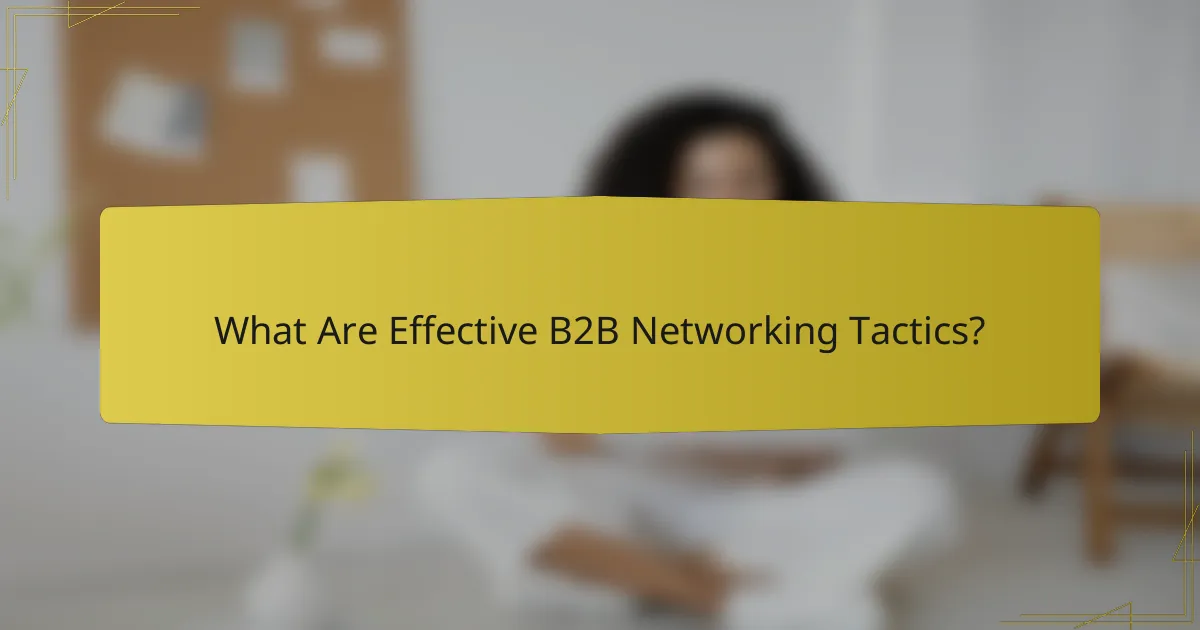In today’s competitive landscape, effective B2B networking tactics are essential for building relationships that enhance business opportunities and market positioning. By leveraging connections, participating in relevant events, and engaging with communities, businesses can foster collaboration and growth while differentiating their offerings to meet the specific needs of their target audience.

What Are Effective B2B Networking Tactics?
Effective B2B networking tactics involve strategic approaches to build relationships that can enhance business opportunities and market positioning. These tactics focus on leveraging connections, participating in relevant events, and engaging with communities to foster collaboration and growth.
Leveraging LinkedIn for Connections
LinkedIn is a powerful platform for B2B networking, allowing professionals to connect with industry peers and potential clients. To maximize your presence, ensure your profile is complete and showcases your expertise and offerings.
Engage with your network by sharing valuable content, commenting on posts, and joining relevant groups. Regularly reaching out to new connections can lead to fruitful discussions and opportunities.
Participating in Industry Conferences
Industry conferences provide excellent opportunities for face-to-face networking. Attending these events allows you to meet key players in your field, learn about market trends, and showcase your business.
Consider preparing a brief elevator pitch and business cards to facilitate introductions. Participating in panel discussions or workshops can also increase your visibility and credibility within the industry.
Utilizing Networking Platforms like Meetup
Meetup is a great platform for finding and creating networking events tailored to specific industries or interests. By joining groups relevant to your business, you can connect with like-minded professionals and expand your network.
Organizing your own Meetup event can position you as a thought leader and attract potential clients or partners. Aim for regular gatherings to build ongoing relationships and foster collaboration.
Engaging in Online Forums and Communities
Online forums and communities, such as Reddit or specialized industry platforms, offer spaces for discussion and knowledge sharing. Actively participating in these communities can help you establish authority and connect with potential collaborators.
Focus on providing valuable insights and answering questions to build trust. Avoid overt self-promotion; instead, aim to contribute meaningfully to discussions.
Hosting Webinars and Workshops
Webinars and workshops are effective ways to showcase your expertise and engage with your audience. By offering valuable content, you can attract potential clients and partners while building your brand’s reputation.
Promote your events through social media and email marketing to reach a wider audience. Ensure to follow up with participants afterward to nurture relationships and explore further collaboration opportunities.

How to Position Your Business in Competitive Markets?
To effectively position your business in competitive markets, focus on differentiating your offerings and understanding your target audience. This involves identifying what makes your products or services unique and how they meet the specific needs of your customers.
Identifying Unique Selling Propositions
Your unique selling proposition (USP) is what sets your business apart from competitors. It could be superior quality, exceptional customer service, or innovative features. Clearly define your USP to communicate the value you provide to potential clients.
Consider conducting surveys or interviews with existing customers to uncover what they perceive as your strengths. This feedback can guide you in refining your USP and ensuring it resonates with your target market.
Analyzing Competitor Strategies
Understanding competitor strategies is crucial for effective market positioning. Analyze their pricing, marketing tactics, and customer engagement methods to identify gaps in the market. This can help you position your business more effectively.
Utilize tools like SWOT analysis (Strengths, Weaknesses, Opportunities, Threats) to evaluate competitors. This structured approach allows you to pinpoint areas where you can outperform them, such as offering better pricing or enhanced features.
Utilizing Market Research Tools
Market research tools are essential for gathering insights about industry trends and customer preferences. Use platforms like Google Trends, SEMrush, or industry-specific reports to inform your positioning strategy.
Regularly review market data to stay updated on shifts in consumer behavior and emerging competitors. This ongoing analysis will help you adapt your positioning as needed, ensuring your business remains relevant and competitive.

What Criteria Should You Use for Networking Events?
When selecting networking events, prioritize criteria that align with your business goals and target audience. Key factors include the relevance of the attendees, the event’s structure, and its accessibility to ensure effective connections.
Target Audience Alignment
Identifying the right target audience is crucial for successful networking. Focus on events that attract professionals from your industry or related sectors, as this increases the likelihood of meaningful interactions. Consider the demographics and roles of attendees to ensure they match your ideal customer profile.
For instance, if your business caters to tech startups, seek events that specifically target entrepreneurs, investors, and tech enthusiasts. This alignment enhances the potential for valuable partnerships and collaborations.
Event Format and Structure
The format and structure of a networking event can significantly impact its effectiveness. Look for events that offer a mix of structured activities, such as panel discussions or workshops, and informal networking opportunities. This combination allows for both knowledge sharing and personal connections.
Consider the duration of the event as well. Shorter events may facilitate quick introductions, while longer formats can allow deeper conversations. Aim for events that provide ample time for networking, ideally with dedicated sessions for one-on-one interactions.
Location and Accessibility
Location plays a vital role in attendance and engagement at networking events. Choose venues that are easily accessible by public transport and have adequate parking options. This consideration ensures that potential attendees can participate without logistical challenges.
Additionally, consider the local context. If the event is in a major city, ensure it is held in a central location that attracts a diverse audience. For virtual events, check the platform’s usability and ensure it accommodates various time zones to maximize participation.

How to Measure the Success of Networking Efforts?
Measuring the success of networking efforts involves evaluating the effectiveness of connections made, the engagement following those connections, and the business opportunities that arise. By focusing on these key metrics, businesses can refine their networking strategies and enhance their market positioning.
Tracking New Connections Made
To effectively track new connections, maintain a database or CRM system that logs each interaction. Record details such as the date, type of event, and the individuals met. This allows for easy reference and helps identify patterns in successful networking scenarios.
Consider setting a goal for the number of connections to make at each event, such as aiming for five meaningful contacts. Regularly review these connections to assess their relevance and potential for collaboration.
Evaluating Follow-Up Engagement
Follow-up engagement is crucial for turning initial connections into lasting relationships. After networking events, reach out within a few days to express appreciation for the conversation and suggest a follow-up meeting or call.
Track responses to your follow-ups to gauge interest and engagement levels. A good benchmark is to aim for a response rate of at least 30-50%. Use this data to refine your follow-up strategies and improve future interactions.
Assessing Business Opportunities Generated
Evaluating business opportunities generated from networking efforts requires tracking leads and conversions that stem from your connections. Set clear criteria for what constitutes a viable opportunity, such as potential partnerships or sales leads.
Utilize a simple tracking system to monitor how many opportunities arise from your networking activities. For instance, if you generate two to three leads from every ten new connections, this ratio can help assess the effectiveness of your networking strategy. Regularly analyze this data to adjust your approach and maximize your networking ROI.

What Are the Best Practices for Building Long-Term Relationships?
Building long-term relationships in a B2B context involves consistent engagement, mutual benefit, and trust. Effective strategies focus on regular communication and providing value, which can significantly enhance partnerships over time.
Regular Communication and Check-Ins
Maintaining regular communication is essential for nurturing long-term relationships. Schedule periodic check-ins, whether through emails, phone calls, or in-person meetings, to discuss ongoing projects and address any concerns. Aim for a frequency that suits both parties, typically every few weeks to months.
During these interactions, be open and transparent about your business developments and listen actively to your partner’s needs. This two-way communication fosters trust and ensures that both sides are aligned on goals and expectations.
Offering Value Before Asking
To build a strong foundation, focus on offering value to your partners before making requests. This could involve sharing industry insights, providing useful resources, or introducing them to potential clients. By demonstrating your commitment to their success, you create a reciprocal relationship.
Consider creating content such as whitepapers or case studies that highlight your expertise and can benefit your partners. This approach not only positions you as a thought leader but also encourages partners to engage with you more openly when you need support in the future.
